Controversies, protests and violence have marred land acquisition for projects in India. Protests against acquiring agricultural land, inappropriate compensation or environmental impact have been the main reasons for these protests.
In most cases, the protests are by farmers who are hardly compensated after their fertile agricultural land is taken over in for various projects. In some cases the protests are instigated by political parties who want to gain mileage by supporting the poor.
Although the Land Acquisition Act means acquiring land for some public purpose by the government as authorised by the law, activists complain that a number of projects, which have no public purpose, as in the case of Special Economic Zones (SEZs), usurped land from property owners at cheap rates, misusing the Land Acquisition Act.
The rehabilitation of land owners does not take place properly. Ultimately, it is the poor who pay the price for development.
India has the highest number of SEZs in the world despite widespread protests against the land-grabbing exercise.
The Posco project in Orissa is the latest example of how the state government manipulated records to state no one inhabited the land taken over for the project. Will the poor farmers ever get their due? What will this kind of development lead to? Is it justified to take over fertile agricultural land for industrial units?
Click NEXT to read about project that have faced the people's wrath...while some shut shop others managed to stifle protests.
The ugly side of land acquisition in India
Image: Mother of Tapasi Malik, Tapasi lost her life during protests against the against the Nano factory.Photographs: Reuters
The Tata Nano project was driven out of Singur in West Bengal after protests by displaced farmers turn violent in October 2008. The plant was shifted to Sanand in Gujarat, from where the small car is likely to roll out on June 2, 2010.
Ironically, after two years the land still remains with the Tatas as the company has taken it on a lease for 90 years. Tatas will not give up the land till they are adequately compensated for the loss incurred by it in 2007-08, during the Singur land controversy.
The company had paid the advance annual lease rent of Rs 1 crore (Rs 10 million) last month for the year 2010-11 much before the deadline. The lease agreement with the government with the company is for a period of 90 years.
Railway Minister Mamata Banerjee, who had led the agitation, now plans to start a rail coach factory at the same site after the West Bengal hand over 400 acres to the unwilling farmers. Around 55 vendors associated with the Nano project had signed individual lease agreements with the West Bengal government.
The annual rental per acre is Rs 8,000 for vendors. Tata Motors has to pay Rs 1 crore a year for the first five years for 646 acres. Bharat Heavy Electricals Ltd expressed an interest in setting up a power plant at the Nano site. However, the company did not go ahead as it did not seem to be feasible.
Protest in Sanand
In December 2009, around 4,000 farmers staged a rally against land acquisition by Gujarat Industrial Development Corporation in villages near Sanand.
GIDC has initiated a process for acquiring more than 5,000 acres of land for industrial purpose in villages near Sanand. Farmers have argued that the fertile land should not be acquired for industrial purposes.
The ugly side of land acquisition in India
Image: Protestors of the Posco project in Orissa.Photographs: Reuters.
Billed as India's biggest foreign direct investment, Posco Rs 52,000 crore ($12 billion) Posco project has been delayed by more than five years due to protests by farmers who are agitating against giving up their fertile agricultural land.
Many have faced the wrath of the police, got injured and killed in protests over the years. Local activists say villagers cannot be allowed to be refugees in their own land. Activists say the project is in clear violation of environmental norms at the cost of the livelihood of thousands of farmers.
Demanding a 'white paper' on the Rs 52,000 crore (Rs 520 billion) steel project, Communist Party of India general secretary A B Bardhan said that although it is billed as India's biggest FDI capable of creating jobs, government must publish details about Posco's cost in terms of loss of land, minerals, water and its adverse impact on poor people.
Meanwhile, CPI leader D Raja, in a letter to Prime Minister Manmohan Singh, said, "Of the 4,000 acres of land, 3,000 acres to be given for Posco's steel plant is classified as forest land. Under the Scheduled Tribes and Other Traditional Forest Dwellers (Recognition of Forest Rights) Act, many of the people of the area are eligible for right over this land, especially the lands they are cultivating, as they have been living in the area for more than 75 years."
Hundreds of families had been using the forest land for their livelihood. Villagers are opposing government plans to lease 4,000 acres of fertile land to Posco for its three iron mining projects in Kandhahar, Kujanga and Paradip.
The ugly side of land acquisition in India
Image: Power woes.In August 2009, hundreds of farmers from Dadri in Ghaziabad district, Uttar Pradesh took out protests against the Reliance power project for "forceful acquisition of fertile land."
They demanded that the land should be returned to them. About 2,500 acres had been acquired for the power project in 2004. Activists said the fertile land belonged to about thousand families in seven villages of Dadri.
The compensation for land was fixed at the rate of Rs 135 per square metre, when the market rate of land at that time in Noida phase 2 was Rs 15,000 per square metre. The Kisan Kalyan Samiti also said farmers who protested were booked under fake cases.
The agitation has been going on ever since the then Mulayam Singh government gave its nod to set up the mega power project.
Meanwhile, Reliance Power said the protests were instigated by rivals. The company plans to invest Rs 40,000 crore (Rs 400 billion) to set up the 8,000 megawatt gas-based project.
The ugly side of land acquisition in India
Image: Women shout slogans during a demonstration by people displaced by proposed SEZ near Mumbai.Photographs: Arko Datta/Reuters.
Despite protests, the proposed Reliance Special Economic Zone at Navi Mumbai has received the government's approval for 1,150 hectares of land. The City and Industrial Development Corporation of Maharashtra Ltd, the nodal agency for the development of the SEZ, holds 26 per cent equity in the SEZ, the rest being held by Reliance.
Out of the total SEZ area, 15 per cent would be for residential purposes and the remaining 85 per cent for industrial purpose. The company would provide the electricity for the SEZ.
Meanwhile, its plans to set up an SEZ over 10,000 hectares in Raigad district got a setback after the Supreme Court judgment dismissing Reliance Industries' special leave petition seeking a stay on land acquisition proceedings for its SEZ in Raigad.
The company has acquired only 2,151 hectares. The Maha Mumbai Shetkari Sangharsh Samiti, which led the agitation, was euphoric after the verdict in their favour.
The ugly side of land acquisition in India
Image: Protests against land acquisition.Photographs: Courtesy, landcoalition.org.
Vedanta's Indian arm, Sterlite Industries, has been given a clean chit by the Orissa state pollution control board after conducting checks in the areas near the plant Kalahandi district.
The board had launched a probe after series of allegations activists and locals claiming that about 100 people died of tuberculosis over the past few years by the pollution caused by the plant at Lanjigarh.
However, scientists who collected data and samples from different sources, including data from local health department reported only one death due to tuberculosis in the area of the refinery between 2002 and 2010.
As per the Supreme Court diktat, 5 per cent of the profit from this project is to be spent on development of local area. The company was given wants permission to mine the Niyamgiri hill for bauxite.
The hill in Lanjigarh block is inhabited by Dongaria Kondhs, a tribal group which said pointed out that mining would pollute their rivers and destroy the jungles.
The ugly side of land acquisition in India
Image: Protestors fight for their land.Tata Steel now plans to go ahead with its much-delayed Kalinganagar project. The company has shifted around 800 out of the 1,150 families.
It plans to rehabilitate the remaining families soon. The Kalinganagar steel project has been delayed by over four years escalating the project cost to Rs 21,000 crore (Rs 210 billion) from Rs 15,400 crore (Rs 154 billion).
The steelmaker had signed a memorandum of understanding with the Orissa government in November 2004 for setting up the integrated steel plant at Kalinganagar.
The protest against Tata Steel's project was spearheaded by the Visthapan Virodhi Jana Manch. VVJM was formed after the death of 14 people in a police firing on January 2, 2006 when the tribals clashed with the police while opposing the construction of the steel plant's boundary wall.
Tata Steel's steel project at Gopalpur in Ganjam also faced resistance from locals.
The ugly side of land acquisition in India
Image: An activist of Communist Party of India (Marxist-Leninist) shouts anti-government slogans.Photographs: Parth Sanyal/Reuters.
Thousands of villagers from the Khunti and Gumla areas of Jharkhand have raised their voice against ArcelorMittal's steel project.
They have accusing the state government's move to sell land to the company as gross violation of the Chotanagpur Tenancy Act, which prohibits sale of tribal land to non-tribals.
The company plans to invest Rs 40,000 crore (Rs 400 billion) for 11,000 acres of land in Khunti and Gumla districts for the proposed 12 mtpa steel plant.
The ugly side of land acquisition in India
Image: Protests against Coca-Cola.Photographs: Courtesy, indiaresource.org.
Beverage giant Coca-Cola ran into rough weather in Plachimada in Kerala after the state Agricultural University found that fodder, milk, and egg samples collected from the Plachimada area contained copper, cadmium, lead and chromium at levels considered toxic by World Health Organisation.
The Indian unit of Coca-Cola Co has been asked to pay $47 million compensation for causing environmental damage in Kerala. The company was forced to shut down the plant.
Similar protests against its bottling plant have taken place in Uttar Pradesh and Rajasthan. In Rajasthan, people have held protests against over-exploitation of groundwater resources. Despite this, the company built a new plant in 2000, leading to water shortages in at least 40 villages.
The ugly side of land acquisition in India
Image: Enron, a total failure.Enron's Dabhol Power project in Maharashtra was marred by several protests, bribery charges, brutal action against opposition by local and activists.
It was warned that this project would cause environmental destruction and displace thousand of people. Local people had raised fears on rehabilitation and water usage for the huge power plant.
Enron had hired security forces to attack protesters. However, the Enron project in Maharashtra eventually led to the bankruptcy of the Enron Corporation, an American energy company.

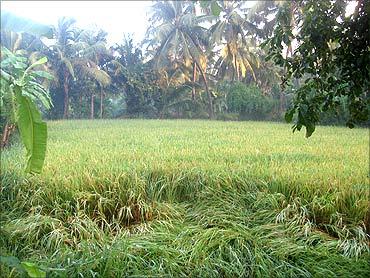

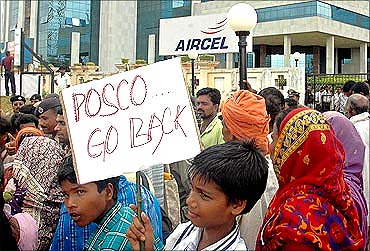
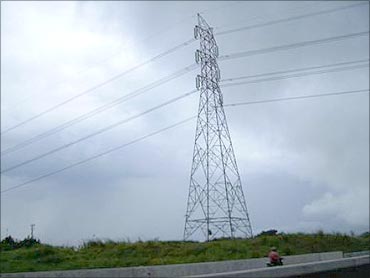


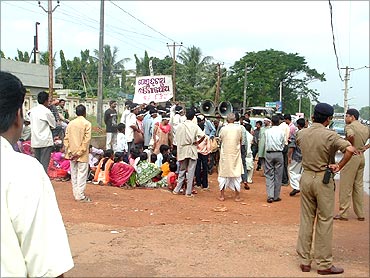
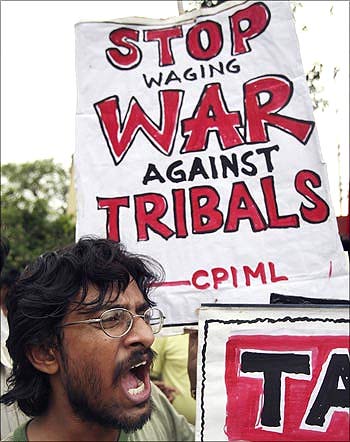


article